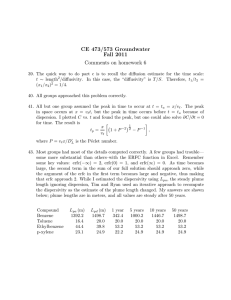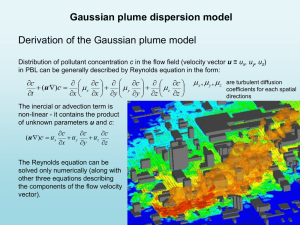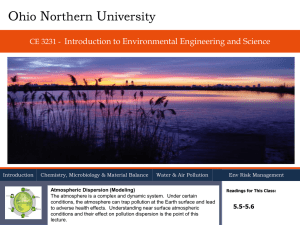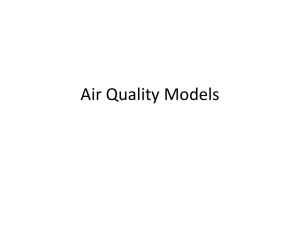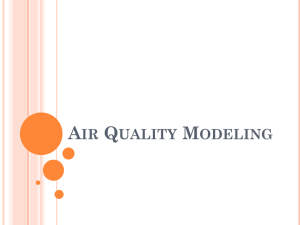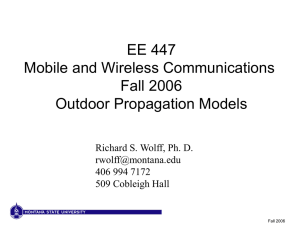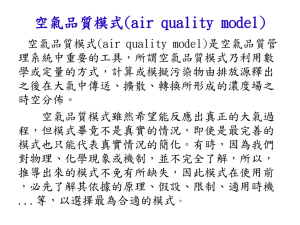Lecture series 8 - Civil and Environmental Engineering | SIU
advertisement
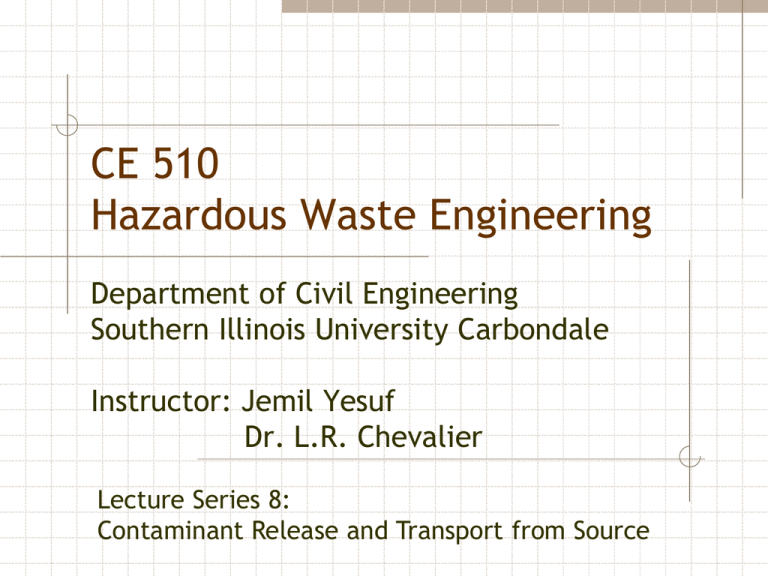
CE 510 Hazardous Waste Engineering Department of Civil Engineering Southern Illinois University Carbondale Instructor: Jemil Yesuf Dr. L.R. Chevalier Lecture Series 8: Contaminant Release and Transport from Source Course Goals Review the history and impact of environmental laws in the United States Understand the terminology, nomenclature, and significance of properties of hazardous wastes and hazardous materials Develop strategies to find information of nomenclature, transport and behavior, and toxicity for hazardous compounds Elucidate procedures for describing, assessing, and sampling hazardous wastes at industrial facilities and contaminated sites Predict the behavior of hazardous chemicals in surface impoundments, soils, groundwater and treatment systems Assess the toxicity and risk associated with exposure to hazardous chemicals Apply scientific principles and process designs of hazardous wastes management, remediation and treatment Pathways of Contaminants Dispersion Of Air Pollutants Focus on a basic point source Gaussian dispersion model Assumptions: Atmospheric stability is uniform Turbulent diffusion is a random activity Dilution in both the horizontal and vertical direction can be described by Gaussian or normal equations Dispersion Of Air Pollutants Assumptions (continued) Contaminated gas stream is released into the atmosphere at a distance above the ground equal to the physical stack height plus the plume rise Degree of dilution of the effluent plume is inversely proportional to the wind speed Pollutant reaching the ground level is totally reflected back into the atmosphere like a beam of light striking a mirror at an angle ( image source) Instantaneous Plume Boundary H h Time Averaged Plume Envelope z x H y (x,-y, z) (x,0,0) h (x,-y,0) Gaussian Plume Model C x , y ,0 , H Q exp s y s z u 2 1 y exp 2 s y 1 H 2 2 s z Eqn. 8.22 (Textbook) where: C (x,y,0,H) = downwind conc. at ground level(z=0), g/m3 Q = emission rate of pollutants, g/s sy, sz = plume standard deviation, m u = wind speed, m/s x,y,z and H = distance, m Effective Stack Height The value for the effective stack height, H, is the sum of the physical stack height, h, and the plume rise DH. DH may be computed from Holland’s formula (J.Z. Holland, 1953, A Meteorological Survey of the Oak Ridge Area, U.S. Atomic Energy Commission Report No. ORO-99, Washington D.C., U.S. Government Printing Office) Plume Rise vs d DH 1 . 5 u Ts Ta 2 2 . 68 10 P d Ts where vs = stack velocity, m/s d = stack diameter, m u = wind speed, m/s P = pressure, kPa Ts = stack temperature, K Ta = air temperature, K Gaussian Plume Model K E Y T O S T A B IL IT Y C A T E G O R IE S S u rface w in d D ay In co m in g so lar rad iatio n sp eed (at 1 0 m ) (m /s) S tro n g M o d . S lig h t < 2 3 5 > 2 -3 -5 -6 6 A A -B B C C A -B B B -C C -D D B C C D D N ig h t T h in ly o v ercast o r < 3 /8 clo u d > 4 /8 lo w clo u d E D D D (see Table 8.1) p. 416 F E D D Gaussian Plume Model C x , y ,0 , H Q exp s y s z u 2 1 y exp 2 s y Need to evaluate these terms, which are the standard deviations of the plume 1 H 2 2 s z Gaussian Plume Model Martin, D.O., 1976. Comment on “The Change of Concentration Standard Deviation with Distance”, J. Air Pollut. Control Assoc., 26:145-147. sy = ax0.894 sz = cxd + f where x is the distance downwind, expressed in km, s is in m, and a,c,d, and f are constants found in the following table: NOTE: Alternatives are graphs 8.10 and 8.11 Gaussian Plume Model S tability C ategory A B C D E F a 213 156 104 68 50.05 34 c 440.8 106.6 61 33.2 22.8 14.35 x 1 km d 1.941 1.149 0.911 0.725 0.678 0.74 f 9.27 3.3 0 -1.7 -1.3 -0.35 c 459.7 108.2 61 44.5 55.4 62.6 x 1 km d 2.094 1.098 0.911 0.516 0.305 0.18 f -9.6 2 0 -13 -34 -48.6 Example Consider the emission of SO2 from a coal fired power plant, at a rate of 1,500 g/s. The wind speed is 4.0 m/s on a sunny afternoon. What is the centerline concentration of SO2 3 km downwind (Note: centerline implies y=0). Stack parameters: Height = 130 m Diameter = 1.5 m Exit velocity = 12 m/s Temperature = 320°C (593° K) Atmospheric conditions: P=100 kPa T=25° C (298° K) Strategy Strategy Determine the effective stack height Dh H = Dh + h Determine stability class Estimate sy and sz Apply governing equation Equations C x , y ,0 , H Q exp s y s z u vs d DH 1 . 5 u sy = ax0.894 sz = cxd + f 2 1 y exp 2 s y 1 H 2 2 s z Ts Ta 2 2 . 68 10 P d Ts Solution 12 m s 1 . 50 m 593 298 2 DH 1 . 5 2 . 68 10 100 1 . 5 4 .0 m s 593 4 . 5 m 3 . 43 15 . 44 m H = effective stack height = h + DH = 130 m + 15.4 m = 145.4 m Solution Atmospheric stability class: Class B sy = ax0.894 = 156(3)0.894 = 416.6 m sz = cxd + f = 108.2(3)1.098 + 2 = 363.5 m Solution 1 1 145 . 44 1500 C x, y, z, H exp 0 exp 416 . 6 363 . 5 4 . 0 2 363 . 5 4 exp 0 .08 4 0 .923 7 . 88 10 7 . 88 10 7 . 28 10 4 3 g m of SO 2 728 . 6 g m 3 ... end of problem 2 Example Simplify the Gaussian dispersion model to describe a ground level source with no thermal or momentum flux, which is the typical release that occurs at a hazardous waste sites. In this situation, the effective plume rise, H, is essentially 0. Solution C x , y ,0 , H Q exp s y s z u 2 1 y exp 2 s y C x , y ,0 , H Q exp s y s z u 2 1 y exp 0 2 s y C x , y ,0 , H 2 Q 1 y exp s y s z u 2 s y 1 H 2 2 s z Puff Models Instantaneous one-time release of material Ground level C x , y , z, t 1 x ut Q 'm exp 3 2 s x 2 2s xs ysz where C is the concentration at (x,y,z,t) in mg/m3 Q’m is the mass of contaminant released (mg) 2 2 y z 2 2 sy sz 2 Puff Models C x , y , z, t 1 x ut Q 'm exp 3 2 2 s x 2 s xs ysz 2 2 y z 2 2 sy sz 2 For the plume dimensions (i.e. s) we will need to refer to Figures 8.8 and 8.9. Example A hazardous waste spill has occurred, releasing 10 kg of TCE into the air. If the spill was at night under mostly overcast skies, and the wind velocity was 7 m/s in the x-direction, estimate the TCE concentration 0.5 km downgradient. Similar to Example 8.2. Instead of evaluating the spill at 0.5 km, evaluate the spill at 1 km. Compare s values as well as final value. Strategy Strategy Determine the class Estimate sx, sy, and sz Estimate C from the governing equation C x , y , z, t 1 x ut Q 'm exp 3 2 s x 2 2s xs ysz 2 2 y z 2 2 sy sz 2 Solution 1. Determine the class given u = 7 m/s, night overcast Class D – use unstable 2. Estimate sx, sy, and sz for x=1000 m Assume sx = sy = 70 m(see p. 417) Also, sz =70 m Solution 3. Calculate t = s/u = 1000 m/ 7 m/s = 142 s 4. Estimate C (1000m, 142 s) Check answer with class Compare values and discuss Subsurface Transport of Contaminants Darcy’s Law Pulse model Erfc Plume model Retardation Decay DARCY’S LAW The first experimental study of groundwater flow was performed by Henry Darcy in 1856. Q Q KA dh dl where Q = volumetric discharge (L3/T) K = hydraulic conductivity (L/T) A = cross-sectional area (L2) dh/dl = gradient of the hydraulic head Q Specific Discharge q K dh dl The specific discharge, also called the darcian velocity, is slower than the average linear velocity. Darcian velocity assumes that the total cross sectional area is available for flow. In reality only a percentage of that area is available (effective porosity). In reality, water has to move faster to maintain the same discharge. Q A Controlling Processes Three basic mechanisms controlling contaminant transport in environmental systems: Advection Diffusion Dispersion Advection Movement of the solute with the bulk water in a macroscopic sense Is the main mechanism driving the movement of solute Advective flux ignores the microscopic processes, but simply follows the bulk Darcian flow vectors Class example A chemical spill occurs above a sloping, shallow unconfined aquifer consisting of medium sand with K=1 m/d and a Φ of 0.3. Several monitoring wells are drilled in order to determine the regional hydraulic gradient. The hydraulic head from a well drilled near the spill location yielded a value of 5m. At a distance of 200m down the slope another well yielded a hydraulic head of 1m. How long it will take for the contaminants to travel 200m. Diffusion Mass transfer by random molecular motion caused by concentration gradient Governed by Fick’s law (second law) C t C 2 Dd with solution x 2 x C ( x , t ) C o erfc ( ) 2 D t Where C = concentration at distance x and time t Co = initial concentration D* = effective diffusion coefficient erfc = the complimentary error function erfc ( y ) 1 2 y e 0 r 2 dt Class Problem Assume Landfill A contains Na+1 = 10,000 mg/l and Ca+2 = 5,000 mg/l and assume Landfill B contains Fe+2 = 750 mg/l and Cr+3 = 600 mg/l. Landfill A has a 6 m clay liner under the waste and Landfill B has 3 m of clay liner under the waste. Assuming diffusion is the only process affecting solute transport, which of the four species will break through the clay layer in either of the landfills first? How long will that take? The effective diffusion coefficients D* for the solutes are: Species D* (m2/sec) Na+1 1.33E-09 Ca+2 7.05E-10 Fe2+ 7.19E-10 Cr3+ 5.94E-10 Solution Waste Clay Waste Clay 3m 6m Land fill B Land fill A The erfc(z) function has non-zero values only at z values less than 3. To solve this problem assume times and calculate at edge of clay layer for each case and keep changing the time until z has a value of 3. WHY? z x 2 D t Spreadsheet Dispersion Mixing which occurs due to differences in velocity field Movement away from the solute mass due to deflection caused by particles that obstruct flow Dispersion increases with increasing scale as each new dispersive process is added to those which occur at all of the lower scales Dispersion Define D, Hydrodynamic dispersion to include mechanical dispersion and molecular diffusion as; D = Dmech + D0 The importance of diffusion and dispersion is assessed based on Peclet number, Pe, the ratio of dispersion effects to diffusion effects Pe = ud D where d is mean grain size. Transport by Advection Position of input water at time t C/Co 1 0.5 0 Distance, x Transport by Advection This “plug flow” is due to advection alone C/Co 1 0.5 0 Distance, x Transport by Advection Tracer front due to diffusion C/Co 1 0.5 0 Distance, x 2-D Flow in Homogeneous, Isotropic Porous Media C 2 DL x 2 C 2 DT y 2 vx C x C t Assuming a uniform velocity field Direction of flow parallel to x-axis Hydrodynamic Dispersion C/Co 1 to Direction of transport, x Hydrodynamic Dispersion t1 C/Co 1 to x1 Direction of transport, x Hydrodynamic Dispersion t1 t2 C/Co 1 to x1 Direction of transport, x x2 Hydrodynamic Dispersion t1 t2 C/Co 1 to x1 x2 Plan view Hydrodynamic Dispersion t1 t2 C/Co 1 to x1 x2 Plan view Hydrodynamic Dispersion t1 t2 C/Co 1 to x1 x2 Plan view Hydrodynamic Dispersion sL C The concentration in this Gaussian curve can be modeled to have an average and a standard deviation Hydrodynamic Dispersion sL As a result, we have an alternate formula for DL and DT DL C DT s 2 L 2t s 2 T 2t 2-D Flow in Homogeneous, Isotropic Porous Media C 2 DL x 2 C 2 DT y 2 vx C x C t Assuming a uniform velocity field Direction of flow parallel to x-axis Methods of Solution - Analytical Need to consider initial and boundary conditions Boundary conditions (in this case our dependent variable is C as opposed to h) Dirichlet: fixed concentration Neumann: fixed gradient Variable flux Applied Problem Give a physical interpretation of the following initial and boundary conditions C 0, t C o t 0 C x ,0 0 x0 C , t 0 t0 Solution For all time t 0, at x=0 the concentration is maintained at Co (Dirichlet boundary) The background concentration is zero at t =0 for all x 0 As soon as flow starts, the solute concentration Co will cross the x=0 boundary Solution The third condition states that the flow domain is infinitely long, and that the concentration will be zero at the end of the system This is important to the derivation of the analytical solution Slug Injection into a Uniform 2-D Flow Field initial point injection C x, y, t Co A 4 t D L D T 1 2 exp x 2 xo v xt 4DLt y 2 yo 4 DT t Slug Injection into a Uniform 2-D Flow Field (0,0) C x, y, t Co A 4 t D L D T 1 2 exp x 2 xo v xt 4DLt y 2 yo 4 DT t Problem Given the following equation for a slug injection into a uniform 2-D flow field, what is the equation for the maximum concentration at any given time? C x, y, t Co A 4 t D L D T 1 2 exp x xo v xt 4DLt 2 y 2 yo 4 D T t Solution Assume the initial injection is at x=y=0 Assume the flow is in the x-direction The center of the mass would be at y=0 x=vxt Solution (0,0) x=vxt1 x=vxt2 Solution C max Co A 4 t D L D T 1 2 Co A 4 t D L D T 1 2 Co A 4 t D L D T x exp v x t 0 v x t 2 exp 0 1 2 Co A 4 t D L D T exp 1 2 xo v xt 2 4DLt 4DLt y 2 yo 4 D T t 0 0 4 D T t 2 Additional Considerations…. C max Co A 4 t D L D T Recall, s x 1 2 2DLt s y 2 DT t By definition then, 99.7% of the mass of contamination will be contained within an area represented by 3s away from the center of mass. Thus the plume can be defined by the location of the center of the mass, 3sx and 3sy Additional Considerations…. (0,0) x=vxt 3 2 DT t 3 2 D Lt Applied Problem Given the following data at 140 days, determine the extent of the plume. Cmax = 450 ppm DL = 0.984 m2/d DT = 0.1DL Solution s s x y 2 0 . 984 275 . 52 m 2 0 . 0984 27 . 552 m m 140 d 2 d 2 m 16 . 6 m 2 d 2 140 d 5 .2 m The leading edge of the plume is 3sx = 3(16.6) =50m ahead of the center of mass (located at vxt). The plume has spread out in the y-direction 3sy = 3(5.2) =15.6 m. Laboratory Experiment t=0 Inject solute Soil column t=to Inject solute Field Scenario aquifer Analytical Solution C C C DL 2 vx x x t 2 For the boundary conditions C 0, t Co t 0 C x ,0 0 x 0 C , t 0 t 0 Co C erfc 2 L v xt vx L exp erfc DL 2 D Lt L v xt 2 D Lt Analytical Solution Co C erfc 2 L v xt vx L exp erfc DL 2 D Lt L v xt 2 D Lt Under certain conditions, we can drop this term. Erfc Mathematical function related to the normal, or Gaussian distribution This means that the solute concentration is normally distributed erfc(B) = 1 - erf(B) erfc(-B)=1 + erf(B) erfc(0) =1 erfc(B) = 0 for B>3 Erfc erf B 2 B e t 2 dt 0 This equation cannot be solved analytically. Can find tables of values. It can also be approximated by the analytical expression: erf B 4B 1 exp 2 Erfc 1 0.8 0.6 erf erfc 0.4 0.2 0 0 1 2 3 Problem Compute concentration at L=200m for the following conditions: Co = 1757 g/m3 vx = 7.67x10-6 m/s DL = 3.8 x 10-5 m2/s t = 6 months (1.58 x 107 s) Make two calculations, one with the short and one with the long form of the equation. What is the % difference? Solution C 1757 g m erfc 3 2 18 . 07 g m 200 m 7 . 67 x 10 6 m 1 . 58 10 7 s s 2 3 . 8 10 5 m 2 1 . 58 10 7 s s 2 Co C erfc 2 L v xt vx L exp erfc DL 2 D Lt L v xt 2 D Lt This term equals zero Solution x 140 160 180 200 220 C (partial eqn) 462.40 206.86 70.60 18.07 3.43 C (full eqn.) ea 533.10 13.26 243.94 15.2 70.60 0 18.07 0 3.43 0 Bear (1979 p. 268) states that the second term can be neglected when vxL/D > 500, since the error < 3%. Note, vxL/D is the Pechlet number. Solution x 140 160 180 200 220 C (partial eqn) 462.40 206.86 70.60 18.07 3.43 C (full eqn.) ea 533.10 13.26 243.94 15.2 70.60 0 18.07 0 3.43 0 Retardation As a result of sorption processes, some solutes will move more slowly through the aquifer than the ground water that is transporting them R C t C 2 D x 2 v C x Example: Analytical Solution Co C erfc 2 L v xt v L exp x erfc DL 2 D Lt RL v t Co x C erfc 2 RD t 2 L L v xt 2 D Lt RL v t vx L x exp erfc D 2 RD t L L Retardation As a result of sorption processes, some solutes will move more slowly through the aquifer than the ground water that is transporting them C t D C 2 R x 2 v C R x Sorption decreases the value of the transport parameters D and v Retardation C/Co x2=vct x1=vwt (w/ conservative tracer) The velocity of the contaminant is less than the velocity of the groundwater Retardation x/L = 1 1.00 0.80 R>1 R=1 C/Co 0.60 0.40 0.20 0.00 0.00 0.50 1.00 t* 1.50 2.00 Problem Given the following graph, sketch C/Co vs x/L for t* = 1 and t* =2. x/L = 1 1.00 0.80 R>1 R=1 C/Co 0.60 0.40 0.20 0.00 0.00 0.50 1.00 t* 1.50 2.00 Solution t* = 1 1.00 C/Co 0.80 0.60 R>1 0.40 R=1 0.20 0.00 0.00 0.20 0.40 0.60 x/L 0.80 1.00 Solution t* = 2 1.00 C/Co 0.75 0.50 0.25 R>1 R=1 0.00 0.00 0.50 1.00 x/L 1.50 2.00 1.00 0.90 0.80 0.70 0.60 0.50 0.40 0.30 0.20 0.10 0.00 0.00 0.10 0.20 0.30 0.40 R > 1 (@ 0 x/L 1 0.50 0.60 0.70 0.80 0.90 1.00 1.00 2.00 t* R = 1 (@ 0 x/L 1 C/Co C/Co Solution 1.00 0.90 0.80 0.70 0.60 0.50 0.40 0.30 0.20 0.10 0.00 0.00 0.10 0.20 0.30 0.40 0.50 0.60 0.70 0.80 0.90 1.00 1.00 t* 2.00 Decay Modify the approximate solution for 1-D dispersion to include radioactive decay Lv t x C erfc 2 D t 2 L Co C Lv t o x C erfc 2 D t 2 L ln 2 t e Summary of Important Points and Concepts Release of contaminants from a hazardous waste source is a function of their sorptivity, volatilization rate and transformation rate. Transport is controlled by advective and dispersive processes in air and water. Analytical solutions are based on boundary conditions that mathematically represent continuous or instantaneous release of the contaminant Summary of Important Points and Concepts The advection-dispersion equation for soil may be modified for contaminant sorption and transformation using the retardation factor and a term for first order degradation, respectively
